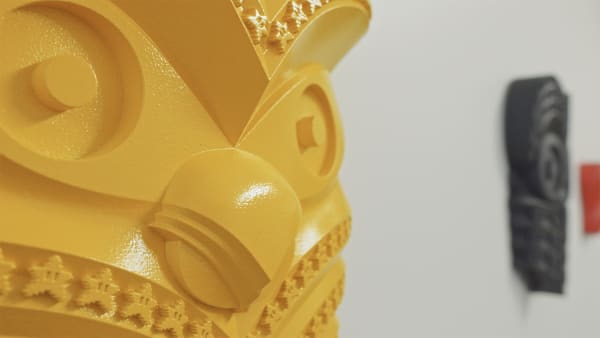Kereama Taepa, Whakapī
Exploring the infinite possibilities of digital technologies and how they may be employed to transmit mātauranga Māori, Kereama Taepa creates artworks that shift between digital, physical, virtual, and augmented realities.
Kereama Taepa is an innovator.
Kereama uses digital technologies like 3d modeling, 3d printing, and virtual and augmented reality software to create works and experiences that shift between digital, physical, virtual, and augmented realities. His practice explores the infinite possibilities of digital technologies and how they may be employed to transmit mātauranga Māori.
This new series of four masks connect Kereama’s love of arcade games and popular culture with the customary carving language of the human face — connecting contemporary culture with the past. The forms of the koruru and whekū follow customary conventions — however, the detailing of the pākati (repetitive notch patterns) are replaced by characters from iconic games and gaming, such as Mario and Pac-Man. This contemporary reference tells the stories of the arcades of the 80s and 90s — a place and culture lost to the youngsters of today.
Kereama conceived a new term “whakapī” for this ongoing series of works. It references the term “whakairo”, the reductive process of carving. However, instead of ‘iro’, Kereama has used ‘pī’ to reference the way bees excrete wax to build their hive, an additive process similar to how a 3D printer works. These masks are digitally modeled and then printed using a 3d printer with polyamide. They are then colored with a lacquer finish.
Kereama Taepa has a Masters degree in Māori Visual Arts from Massey University, Palmerston North, and is a lecturer within the Bachelor of Creative Industries at Toi Ohomai Institute of Technology, Rotorua. He has exhibited nationally and internationally and has works in collections across Aotearoa. He has been commissioned for several major public artworks, including Tohorā at Maclean Park, Paraparaumu, 2020; a (very) brief history of Aotearoa, the Four Plinths Sculpture Project outside Te Papa, Te Whanganui-a-Tara, Wellington, 2016; and Tichi in Ngāmotu, New Plymouth in 2015.








